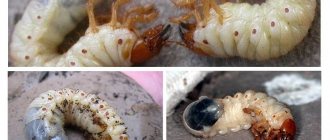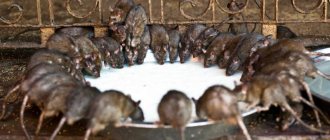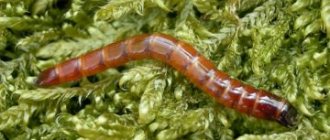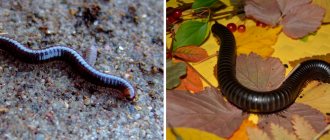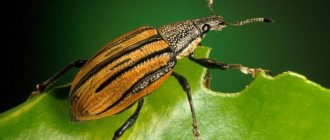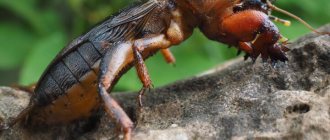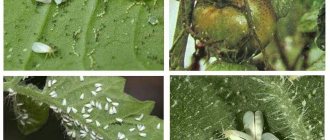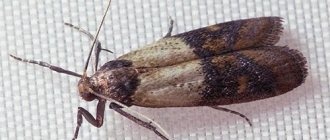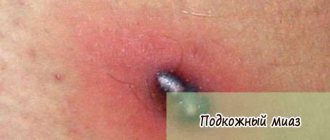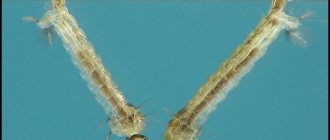May beetle (Khrushchev) and its furrow larvae
If you find large, thick white larvae in the ground in your beds, most likely these are the offspring of the cockchafer. The May beetles themselves (they are also called Khrushchev) are familiar to every child - they are large brown-brown insects with a hairy body and legs. Their mass emergence is observed in the spring, and at the very beginning of June the females lay eggs, preferring compost heaps or beds with sandy or sandy loam soil, from which the larvae hatch.
It is not difficult to recognize these pests by sight - the larvae of the cockchafer are large (up to 6 cm), thick, yellow-white, with a rounded reddish-red head and three pairs of legs in the front, always as if “curved” in the letter C.
The larva of the May beetle, unfortunately, can easily be confused with the larva of the rhinoceros beetle found in the south of the country, which looks almost the same, but can be even larger. This beetle itself is protected in many territories, and its larvae are practically harmless to the gardener, because. They feed only on decaying plant matter and can damage the roots of cultivated plants only by accident.
Although the adult May beetles themselves also feed on the leaves, buds and flowers of various trees and shrubs, it is their voracious larvae that cause particular trouble in the garden. They live in the soil, develop over 3-5 years, and during this time they are capable of causing significant damage to more than one crop, devouring the roots and tubers of almost any plant at a very decent speed.
How to get rid of cockchafer larvae? It is quite difficult - an integrated approach is important here, since the use of any one method often turns out to be ineffective. First of all, the larvae are collected by hand, and the soil must be mulched. Modern insecticides (Antikhrushch, Bazudin, Zemlin) are applied to the ridges. Plants that repel pests (clover, elderberry, lupine, etc.) are also planted on the site. The biological drug Nemabact is also used, which is safe for humans and the environment.
- May beetle: which plants are threatened and how to deal with its larvae
The appearance of cockchafers in the garden is not a harmless sight, but a serious problem. Don't let pests destroy your plants!
Links[edit]
- Qian, Pei-Yuan (1999), "Larval Settlement of Polychaetes", Reproductive Strategy and Developmental Patterns in the Annelid
, Dordrecht:. Springer Netherlands, pp. 239-253, DOI: 10.1007/978-94-017-2887-4_14, ISBN 978-90-481-5340-4 - Chen, Zhang-Fan; Zhang, Huoming; Wang, Hao; Matsumura, Kiyotaka; Wong, Yue Him; Ravasi, Timothy; Qian, Pei-Yuan (02/13/2014). "A quantitative proteomics study of larval settlement in the amphitrite Barnacle Balanus". PLOS ONE
.
9
(2):e88744. DOI: 10.1371/journal.pone.0088744. ISSN 1932-6203. PMID 24551147. - Sen, R; Gadagkar, R. (2006). “The male social wasp Ropalidia marginata may feed the larvae if given the opportunity.” Animal behavior
.
71
(2): 345–350. DOI: 10.1016/j.anbehav.2005.04.022. S2CID 39848913. - Wakahara, Masami (1996). "Heterochrony and neotenic salamanders: possible clues to understanding animal development and evolution". Zoological Science
.
13
(6):765–776. DOI: 10.2108/zsj.13.765. ISSN 0289-0003. PMID 9107136. S2CID 35101681. - Nagy, Lisa M.; Grbić, Miodrag (1999), "Cellular lineage in larval development and evolution of Holometabolous insects", Origin and Evolution of Larval Forms
, Elsevier, pp. 275-300,. Doi: 10.1016/b978-012730935-4/50010-9, ISBN 978-0-12-730935-4 - Jump up
↑ Raff, Rudolf A (2008-01-11).
"The origin of other metazoan body plans: the evolution of larval forms". Philosophical Transactions of the Royal Society B: Biological Sciences
.
363
(1496):1473–1479. DOI: 10.1098/rstb.2007.2237. ISSN 0962-8436. PMC 2614227. PMID 18192188. - Williamson, Donald I. (2006). "Hybridization in the evolution of animal form and life cycle". Zoological Journal of the Linnean Society
.
148
(4):585–602. DOI: 10.1111/j.1096-3642.2006.00236.x. - Jump up
↑ Moore, R. C. (1959).
Arthropoda I - common features of arthropods, Proarthropoda, common features of Euarthropoda, Trilobitomorpha
. Treatise on Invertebrate Paleontology. Part O. Boulder, CO/Lawrence, KS: Geological Society of America/University of Kansas Press. pp. O121, O122, O125. ISBN 978-0-8137-3015-8. - "Division: Endopterygota - Amateur Entomological Society (AES)". www.amentsoc.org
. Retrieved August 3, 2022. - "Recognition of insect larvae". University of Kentucky. Retrieved April 28, 2016.
- JOHNSON, NORMAN. TRIPLHORN, CHARLES A. (2020). BORROR AND DELONG'S INTRODUCTION TO THE STUDY OF INSECTS
. CENGAGE LEARNING CUSTOM P. ISBN 978-0-357-67127-6. OCLC 1163940863 .CS1 maint: multiple names: authors list (link) - Capinera, John L., ed. (2008). Encyclopedia of Entomology
. Dordrecht: Springer, The Netherlands. DOI: 10.1007/978-1-4020-6359-6. ISBN 978-1-4020-6242-1. - "Types of insect larvae". Agri info. Archived from the original on May 14, 2016. Retrieved April 28, 2016.
Colorado potato beetle and its larvae
The well-known American immigrant, the Colorado potato beetle with its larvae is rightfully considered one of the most dangerous pests of vegetable crops of the Solanaceae family. Elegant striped adult insects and their bright red larvae with a dark head and black legs can literally gnaw away plants, leaving them without leaves, and you without a harvest of potatoes, tomatoes, eggplants, peppers, vegetable physalis...
Because Colorado potato beetle larvae have two rows of dark spots on their sides, some people mistakenly believe they are ladybug larvae. Don’t be confused - the latter are gray in color, “spiny” with orange spots, and also bring great benefits to agriculture, destroying large quantities of dangerous pests such as aphids, psyllids, scale insects and mites.
Colorado beetles overwinter deep in the soil, and in the spring they come out and begin to actively devour the first greenery. The female lays eggs continuously, from spring to autumn - bright orange clutches can be easily found on the underside of the leaves. The hatched larvae, like their parents, have an excellent appetite.
It is not easy to fight the Colorado potato beetle and its larvae - these pests show high resistance to poisons and quickly develop immunity to them, and are also poisonous to most birds and animals.
Natural enemies of the Colorado potato beetle, which are not afraid of its poison, are guinea fowl, pheasants and turkeys, and among insects - tachinas, ground beetles, hoverflies, lacewings and ladybugs. Pest control measures using certain entomophagous parasites are also being studied.
Therefore, again, the best choice would be an integrated approach. It includes manual collection of beetles with larvae and their destruction outside the site, abundant planting of strong-smelling plants in the garden (calendula, lemon balm, basil, mint, dill, coriander, onion, garlic), and the use of systemic insecticides.
Among the folk methods of combating beetles and larvae, the use of onion peels and tar is effective, the smell of which these insects also cannot tolerate. The crushed husks along with the ash are placed in the planting holes. Tar is used as part of a water-soap solution that is used to spray plantings.
- Colorado potato beetle - not easy to get rid of, but possible
Operation Colorado Beetle: find and neutralize!
Mole cricket and its larvae
The terrifying appearance of the burrowing mole cricket beetle is familiar to many gardeners - a large brown, big-eyed insect with claws for digging the ground. And the harm these insidious creatures bring to the site is undeniable - they feed on earthworms and root crops, actively gnawing the roots of cultivated plants during their underground movements, and multiply quickly.
Most often, an inexperienced summer resident can bring a mole cricket to the site along with manure or compost, which these insects also do not disdain as a food product.
But what does a mole cricket larva look like and is it dangerous for the garden? Female mole crickets make nests underground where they lay hundreds of eggs. Hatching larvae have a body shape very similar to an adult insect, only much smaller and lighter, and at first they do not have eyes. They develop over several years, are less mobile than adults, and have weaker jaws, but they eat the same things: small roots, bulbs, worms, plant seeds, and small insect larvae.
Despite the fact that the mole cricket is mainly an underground dweller, it flies and swims beautifully, so it is not easy to catch and destroy it. What to do? Use several methods of pest control at once - both folk and “official”.
Plant marigolds, calendula, chrysanthemums, parsley, onions, and garlic in the garden - their pungent smell is unpleasant to insects. Pour infusion of onion peels or soapy water into the discovered holes made by mole crickets in the ground, or add calcium carbide (after rain it will react chemically with water, releasing acetylene gas, which is poisonous to insects). Use proven chemicals (Medvetox, Antimedvedka, Medvetsid, Rembek, Boverin, Fenaxin Plus, etc.).
- How to deal with mole crickets - effective drugs and folk remedies
Don’t know how to get rid of mole crickets on your property? Our recipes will help you protect your garden crops from this underground pest.
Conclusion
Finally, I would like to answer a frequently asked question regarding self-repair of the mechanism. So, repairing the lock cylinder at home is impossible. More precisely, you can repair it; the key will turn, but the cylinder will begin to open even with a pin. So only replacing the cylinder will help.
Repairing the larva of a house is difficult, almost impossible.
Click beetle and its larvae (wireworms)
Graceful click beetles themselves do not cause harm to garden plantings, since the vast majority of their species do not feed at all as adults. But their larvae, developing in the soil, are serious pests of agricultural crops. They actively eat the roots, tubers and bases of the stems of potatoes, grapes, radishes, lettuce, cabbage, daikon and other plants, which wither and die due to damage.
Click beetle larvae received their second name “wireworms” (or wireworms) for their elongated body with hard, shiny cover from light yellow to dark brown color.
Measures to combat wireworms are different. You regularly need to dig up the soil on the site (especially in late autumn, when the larvae die when exposed to the cold) and plant green manure plants. When planting, spill the soil with a solution of potassium permanganate or embed the already familiar onion peel or mustard powder into it. Arrange traps with roots or young leaves. Treat the plantings with Bazudin (granules are scattered over the beds at the rate of 10-15 g per 10 sq.m).
- 10 ways to deal with wireworms
Find out what wireworm looks like and how to effectively fight it.
Larval stages
Close-up of an adult Triops
(Notostraca), showing the naupliar eye between the two compound eyes
Nauplius
Genus name Nauplius
was published posthumously by Otto Friedrich Müller in 1785 for the animals now known as copepod larvae.
The nauplius stage (plural: nauplii
) is characterized by the use of the head appendage (antennae) for swimming. The nauplius is also the stage in which the simple unpaired eye first appears. The eye is known for this reason as the "naupliary eye" and is often absent in later stages of development, although in some groups it is retained in adult form, such as Notostraca.
Zoya
Rod Zoya
was originally described by Louis Augustin Guillaume Bosc in 1802 for the animal now known as the grub crab.[1]
The zoean stage (plural: zoe
or
zoe
) is characterized by the use of a thoracic appendage for swimming and a large dorsal spine.
Postlarva
Post-larva is characterized by the use of abdominal appendages (pleopods) for movement. The postlarva is usually similar to the adult form, and therefore many names have been erected for the stage in different groups. William Alford Leach raised the Megalopus
in 1813 for the postlarval crab;
and the copepod's postlarva is called a copepodite
;
and the shell postal larva is called cypress
;
and the post-larval shrimp is called parva
;
an Hermit Crab postlarvae are called Glaucothoe
;
the spiny lobster/furry lobster post-larva is called Puerulus
and the slipper lobster post-larva is called
nisto
Pest butterflies and their caterpillars
Butterflies that seem cute at first glance and flutter around the garden can also turn out to be malicious pests. Whiteflies, cutworms, whiteflies, hawthorns, moths, moths - their caterpillars (butterflies do not have a larval stage) can significantly damage your crop. Some of them specialize in legumes, others prefer cruciferous or rose beans, others willingly settle on gooseberries and currants, and still others choose cereals. And they all actively gnaw on young parts of plants (leaves, roots, fruits), choosing for this, as a rule, the night time.
To reduce their harmfulness, measures will have to be taken. Namely:
- promptly destroy weeds (especially flowering ones) that can become a “home” for butterflies;
- during the period of egg laying and caterpillar hatching, regularly deep loosen the soil between the rows, and also do not forget about deep autumn digging of the site;
- during the mass summer, use bowls with beer or jam to catch butterflies;
- to repel insects, place pegs in the garden, wrapped at the ends with rags soaked in undiluted birch tar;
- spray the plantings with a water-tar solution (for 10 liters of water - 2 tablespoons of tar and 20 g of soap shavings) or wormwood infusion (for 10 liters of boiling water - 300 g of crushed wormwood, 1 cup of wood ash and 1 tablespoon of liquid soap – leave for 5-6 hours);
- use biological products (for example, Lepidocide or Bitoxibacillin), release Trichogramma predators into the area;
- in case of mass damage, use chemicals (Decis, Arrivo, etc.).
Content
- 1 Life cycle
- 2 History of the study of crustacean larvae.
- 3 Larval stages 3.1 Nauplius
- 3.2 Zoya
- 3.3 Postlarva
- 4.1 Branchiopods
- 4.5.1 Copepoda 4.5.1.1 Parasitic copepods
"Vegetable" flies and their larvae
The so-called “vegetable” flies (cabbage flies, carrot flies, onion flies, etc.) are also terrible in the garden and vegetable garden, no longer in the adult state, but in the larval stage. In the spring, insects lay hundreds of eggs, from which larvae hatch and begin to actively feed on root crops and young parts of plants (carrot fly larvae, accordingly, specialize in carrots, onion fly larvae - in onions, and so on, although they do not disdain neighboring crops). Affected plants turn yellow, rot and die. After about a month, the larvae pupate in the ground and soon give rise to a new generation of pest flies.
Control measures for fly larvae include uprooting and immediate destruction of yellowed plants. If the number of larvae is very large, it is worth using specialized insecticides.
The main fight against these insects lies in timely prevention of their appearance on the site. This is the choice of varieties that are resistant to this pest, the refusal of fresh manure as fertilizer, mulching the beds, the use of onion peels, a water-tar solution or tobacco leaves as deterrents, and compliance with crop rotation.
- How to save crops from carrot flies
One of the most dangerous pests of carrots, which feeds on seedlings and root crops throughout the season, is the carrot fly.
When digging up beds or caring for plants in the garden, be attentive to any crawling little things. What if a massive invasion is already being prepared for your harvest? Then it’s urgent time to take action!
Entomology
"Maggot" is not a technical term and should not be taken as such; in many standard entomology textbooks, it is not shown in the index at all.[3][4] Many non-technical texts use the term to refer to insects. larvae in general. Other sources have given their own definitions; for example: "The term is applied to a larva when all traces of limbs have disappeared"[5] and "Applied to legless dipteran larvae."[6] Also in Flies: Natural History and Diversity of Diptera
, the author states that the larvae “are the larvae of higher Brachycera (Cyclorrhapha).”[7]
Fly larvae are of great importance in ecology and medicine; Among other roles, various species are involved in the processing of carrion and debris, attacking crops and food products, spreading microbial infections and causing myiasis. Larvae are also especially important in forensic entomology because their development can help determine the time of death, especially larvae in the Calliphoridae family.[8]
